Lenz’s law of electromagnetic induction states that the changing magnetic field cause direction of induced current in such a way that it opposes the changing magnetic field.
Electromagnetic induction is one of the most critical and interesting phenomena based on which different electrical machines, whether big or small, static or dynamic works. Knowingly or unknowingly, we are surrounded by various devices or appliances that make use of the laws of Electromagnetic Induction.
Meaning of Electromagnetic Induction
Electrical and Magnetic forces happen simultaneously in nature. Both of these forces are like two sides of the same coin and they co-exist across space and time. Availability of one can’t be there without the other. That’s why we call it “electromagnetic”. In electrical engineering, we are more interested in time-varying electric currents or magnetic fields instead of static ones. Induction means the influence that one has on the other. It can be the influence of a magnet on a current-carrying conductor or that of the latter on the former. These influences can be understood better by the laws of electromagnetic induction.
Laws of Electromagnetic Induction
Faraday’s first law of electromagnetic induction: states that an induced EMF is generated in a current-carrying conductor when it is taken to a time-varying magnetic field. This time-varying magnetic field as faced by the conductor could be when:
- The magnetic field is rotating relative to the conductor.
- The conductor is rotating relative to the magnetic field.
Faraday’s second law of electromagnetic induction: tells us about the value of this induced EMF which is directly proportional to the rate of change of the magnetic field flux linked with the conductor.
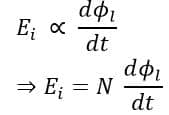
Where,
E is the induced emf
N denotes the number of turns in the coil
Φl is the magnetic field flux linked with the conductor. This is equal to the product of the number of turns of the coil conductor and the associated magnetic field flux.
What is Lenz’s law?
German scientist H. F. E. Lenz gave this law. This law describes the direction of the induced emf in a coil. According to this law, the induced emf in a coil due to a time-varying magnetic field is so as to oppose the very cause of its own creation.
You might be wondering what does that mean? So let’s understand.
Lenz’s Law of Electromagnetic Induction Explained
What Lenz’s law says is that the induced EMF in the coil due to a time-varying magnetic field will try to oppose the same magnetic field which was responsible for its creation. The time-varying magnetic field causes the generation of an emf within the coil and if connected in a closed circuit path, it will lead to a flow of a certain amount of current. This current will therefore generate a magnetic field of its own whose polarity will be so as to oppose the original magnetic field which caused an emf to induce within the coil. In this way, the induced emf opposes the very cause of its own creation.
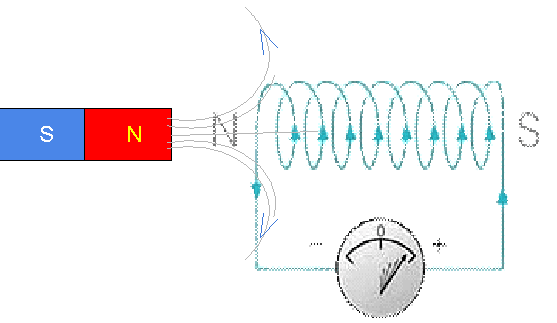
In the given picture, the magnetic North pole approaches the coil causing the generation of an induced EMF. As the circuit is closed, a current flows through the circuit in a direction that can be determined by Fleming’s right-hand rule which results in the generation of a counter-magnetic field with its north pole facing the north pole of the magnet. This happens so that the two similar poles do repel each other thus the induced EMF could be reduced.
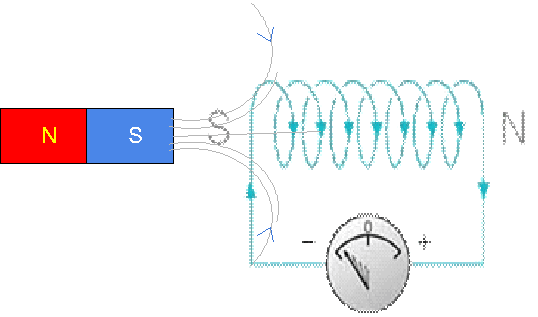
Similarly, here the induced magnetic field flux is so that its S-pole faces the S-pole of the magnet and hence both could repel each other and go far away.
Lenz’s Law Formula
This is represented mathematically by putting a negative symbol with the time-varying magnetic field as shown in Faraday’s law of electromagnetic induction.
The Lenz’s Law Formula is given below.
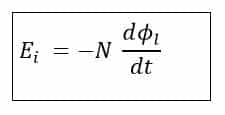
The negative symbol indicates that the induced emf trying to kill the reason that created it which is the time-varying magnetic field.
This is what we discussed in the case of a magnetic field flux generated by a permanent magnet. In electrical machines, however, the time-varying magnetic field is generated by a time-varying current passing through an inductive circuit, and the linked magnetic field flux is given by the product of the inductance of the coil or the inductor and the instantaneous current passing through it. In that case, the induced emf is given by
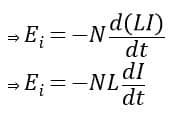
Here L is the inductance of the coil and I denotes the instantaneous current passing through the coil. The inductance L is a constant value and depends on the nature of the coil. On the other hand, the instantaneous current I denotes the current passing through the coil at that moment. As the current is time-varying, the value of I depends on time; hence, it isn’t a constant.
Talking about the inductance ‘L’, it is given as

Where,
µ =permeability in Wb/A.m
N =Number of turns
A = cross-sectional area of the coil (m2)
l = Length of the coil (m)
L = Inductance measured in Henry(H).
Now, let us find the equation of the current flowing through a purely inductive circuit

Applying Kirchhoff’s Voltage Law (KVL) in the given circuit, we get


Here, E is the instantaneous source voltage and hence is dependent on time. Therefore the equation above can be written as

Where ω is the angular frequency given by ω=2πf, f= source frequency in Hz.
Now,

Integrating both sides with respect to the time we get,

Now,

Therefore,

Therefore we can see that for a purely inductive circuit, the instantaneous current lags the source voltage by 90 degrees. This equation can further be simply written as
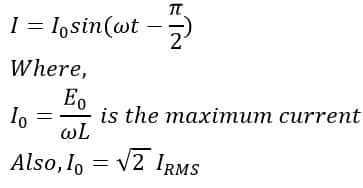
Thus, by using Lenz’s law of Electromagnetic Induction, we can find the instantaneous current in the case of a purely inductive circuit. In the case of a resistive circuit, the current remains in phase with the voltage. But in the case of an inductive circuit, the current lags the source voltage as the inductor-induced EMF opposes the cause of its creation i.e, the current flowing through it. This lag angle can be reduced by adding resistance in the circuit or resistance along with the capacitance.
Lenz’s law and Conservation of Energy
According to the law of conservation of energy, Energy can neither be created nor be destroyed but only one form of energy can be converted into other. Lenz’s law of electromagnetic induction denotes the same. As per Faraday’s second law of electromagnetic induction, the induced EMF is directly proportional to the rate of change of magnetic field flux through the coil.
That means, if the coil is connected in a closed circuit, it will cause a current to flow through the circuit as well as the coil itself. This induced current will therefore result in the generation of an induced magnetic field in the coil which will add up with the original magnetic field and thus the magnetic field gets stronger hence resulting in further generation of higher induced EMF.
This EMF will again cause a current to flow and further generate a stronger magnetic field. This is therefore a violation of the law of conservation of energy as this looks like a source of perpetual energy which is what we don’t find in nature. Also, we don’t find such happening in an inductive circuit as well.
That’s why the negative sign in Lenz’s law tells us what actually happens in nature i.e, it conforms with the Law of Conservation of Energy. In fact, the given equation also conforms with Newton’s third law of motion which states that to every action there is an equal and opposite reaction.
Lenz’s law and Mechanical Inertia
One interpretation of Lenz’s law is that an inductive circuit is analogous to that of inertia in mechanical systems. Just like inertia opposes the change of state of a moving body, an inductor in an electric circuit opposes the change of flow of current through it. This can also be seen in the equation of instantaneous current derived above where the current lags the voltage by 90 degrees in a purely inductive circuit. That is precise because the inductor opposes the flow of current and behaves like an “electrical equivalent of inertia”.
Thus Lenz’s law of Electromagnetic Induction holds great significance and allows us to model circuits containing inductors accurately. All AC machines can be analyzed using this basic equation just like we did above in the case of a purely inductive circuit.
Lenz’s Law Applications
The followings are the application of Lenz’s law.
- With the help of Lenz’s law, we can easily understand the concept of energy storage in inductors. When we apply voltage to an inductor, it opposes the applied voltage by inducing opposite polarity voltage and thus it opposes the flow of current through it. Then, the source has to do work to establish the flow of current in the inductor. On removing the applied voltage, the stored energy in the inductor can be recovered,
- Lenz’s law is also applicable to electric generators and electric motors. The current induced in the generator opposes the causes of rotation and the generator needs more mechanical energy. In the case of motor, the induced emf opposes the main supply and limits the current.
- It is used in electromagnetic braking
- Lenz’s law is used in induction cooktops.
- This law provides a physical interpretation of the choice of sign in Faraday’s law of induction.